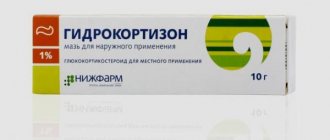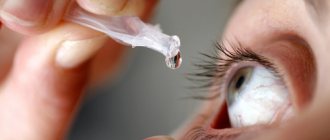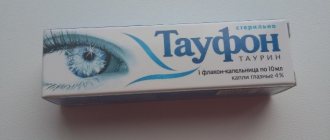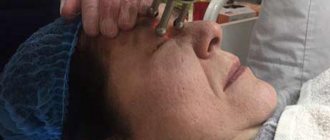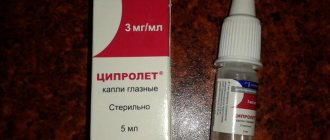Levomycetin drops are a product that should always be present in every first aid kit. This inexpensive medicine effectively copes with various pathologies affecting the organs of vision. Doctors prescribe it for inflammation, intense lacrimation, and the formation of pus in the conjunctival sacs. This medication is considered safe. It can be safely used by adults and even children of different ages. An ophthalmologist will tell you in more detail about the methods of its use and possible contraindications.
Levomycetin eye drops for children
The effectiveness of Levomycetin for conjunctivitis
The main active ingredient of the drug is chloramphenicol. This is a remedy that has a wide range of effects on various bacteria. The solution is prescribed if the patient has developed resistance to the action of penicillin, streptomycin, or sulfonamide.
The action of the drug is carried out by suppressing protein synthesis inside the bacterium. They stop reproducing, their membrane is destroyed. Cells die.
Resistance in bacteria to the drug develops slowly. Therefore, doctors resort to prescribing a solution for a long course of treatment of bacterial conjunctivitis. The addiction does not form for a long time, so the doctor does not need to replace the drug with an analogue.
After instillation of the product, the active substance penetrates the vitreous body and sclera. After this, it is absorbed into the systemic circulation, so there is no effect on the lens. This reduces the number of side effects from the drug.
The effect of the drug after instillation occurs within 20 minutes. The maximum area of effect is observed in the anterior parts of the eye. Therefore, it is used for conjunctivitis and other bacterial formations on the mucous membrane and skin in the eye area.
Indications and contraindications for use
Ophthalmologists prescribe chloramphenicol drops for the treatment of inflammatory processes of bacterial origin, which are localized in the conjunctival sac of the eye or cornea.
Levomycetin is a strong antibiotic. It is indicated for various bacterial diseases. Inflammation, poisoning, purulent lesions of bactericidal origin are relieved by the action of this medicine.
The instructions allow the use of this drug for children from 2 years of age. The dosage for children and the duration of treatment are prescribed individually by a specialist. For severe diseases, Levomycetin drops are prescribed to children under 2 years of age, but children under 1 year of age are recommended to use the drug only when there is no other way to cure the disease.
Instructions for the use of Levomycytin eye drops prohibit children under 2 years from taking the drug, but sometimes treatment with such a strong antibiotic is necessary because children suffer more severe diseases than adults. Therefore, you can drip Levomycetin to children under one year old, but only after a doctor’s prescription.
Studies show that the drug is toxic to the bone marrow, inhibits protein synthesis, and has an aggressive effect on the human body.
Therefore, the prescription of Levomycetin for newborns and its use should be strictly regulated by a doctor. In children under 2 years of age, the use of Levomycetin provokes “gray syndrome,” which is extremely dangerous for the baby. With this syndrome, the baby's kidneys work slowly and there is a lack of enzymes. All this leads to damage to the heart and blood vessels due to intoxication. Substances that the liver cannot cope with accumulate in the child’s body. As a result, young patients experience a bluish-gray color of the skin, impaired breathing and a decreased temperature. In 40% of cases, deaths are recorded.
It should be noted that this medicine has not been sufficiently tested and studied in relation to infants. The specialist prescribing these drops bears personal responsibility for the consequences. That is why doctors are in no hurry to prescribe the drug to infants. However, if there are no contraindications, for example, individual intolerance to the components of the composition, children respond well to treatment with these drops.
Many mothers, having read the instructions for the drug, begin to be suspicious of the prescription of Levomycetin drops by a specialist. Indeed, the instructions for use clearly state caution for children under 2 years of age. However, for the baby, Levomycetin preparations are prescribed in the most minimal doses. This treatment usually does not harm the baby.
One-day or two-week lenses – how to choose
Acuvue daily lenses - everything about these lenses is described here.
Optical lenses for eyes https://eyesdocs.ru/linzy/uxod/opticheskie-osobennosti-i-kriterii-vybora.html
During pregnancy
Levomycetin drops are prescribed for the treatment of conjunctivitis during pregnancy only after examination by an eye doctor. With the inflammation described above, the signs of the disease disappear very quickly, literally in 2-3 days. However, you should not prescribe this drug yourself.
Pregnant women can only use Levomycetin drops. Treatment with tablets is prohibited.
The use of Levomycetin drops is allowed for pregnant women because a minimum dose of the main active ingredient gets into the eyes. It is practically not absorbed into the blood, so the risk of a negative impact on the unborn baby is reduced to almost zero.
But the tableted drug penetrates tissues, including the placenta, negatively affecting the baby. Therefore, while carrying a child, the expectant mother should refrain from taking Levomycetin tablets.
Contraindications
Levomycetin eye drops should not be used in case of renal or liver failure. Also, in case of hypersensitivity to the components of the drug, it is also not used.
If hematopoiesis is impaired, the use of Levomycetin drops should be discontinued.
Features of application
Before prescribing the drug, the ophthalmologist should consult the patient about additional recommendations in the field of its use:
- The solution does not cause clouding or decreased visual acuity. Therefore, it can be used when driving a vehicle or working in an enterprise that requires increased concentration.
- The drug may cause allergic reactions. Therefore, if a patient has eczema or psoriasis, it is necessary to first consult a doctor. The drug is not contraindicated, but is used with caution so as not to cause an exacerbation of the disease.
- If the drug is used for persons after radiation exposure, the dosage is reduced. The active substance may inhibit the function of red bone marrow.
- If side effects occur, you cannot wait for the body to get used to it. The drug is immediately cancelled, consult a doctor.
special instructions
The effect of Levomycetin on children has not been studied enough, so this drug is prescribed only in extreme cases, and it is necessary to make sure that the child is not allergic to the components of the drug.
When using the drug on children under 3 years of age, it is very important to monitor the child’s condition, since the risk of “gray child” syndrome increases, which is very dangerous. The functionality of the kidneys is impaired, this leads to enzyme deficiency; general poisoning of the body can provoke damage to the heart and blood vessels. The child’s body cannot process and remove toxic substances, as a result of which the baby’s skin turns gray, body temperature drops, and respiratory function is impaired.
Do not exceed the dosage and duration of treatment prescribed by your doctor. If atypical symptoms develop, you should immediately consult a doctor.
Levomycetin for conjunctivitis in adults
Before using the drug, wash your hands with bactericidal soap. This will prevent pathogenic microorganisms from entering the packaging and the eye area. Open the bottle, tilt your head back, and drop the product onto the area of the conjunctival sac. After this, do not close the eyes for several seconds so that the solution is distributed throughout the mucous membrane. This way the active agent will affect a wide area of eye tissue.
For adults, the dosage is 1 drop in each eye 3 times a day. The course of treatment is determined by the doctor individually for each patient after a general examination and tests.
Instructions for use
The duration of the course and dosage are selected for the child by the ophthalmologist on an individual basis. Children under one year old are recommended to put drops in their eyes three to four times a day. The therapeutic effect occurs two to three hours after use. Children are prescribed a product with a Chloramphenicol concentration of 0.25%.
IMPORTANT! It is not recommended to use eye drops for more than two weeks.
Let's look at the instructions for use step by step:
Broad spectrum antibiotic eye drops
- Wash your hands with soap and dry.
- Soak a cotton pad in Furacilin solution or chamomile decoction and wipe the visual organ.
- Shake the medicine bottle.
- Pipette the solution into a clean pipette.
- Gently move your baby's head back.
- Gently pull back the lower eyelid.
- Lightly press the dropper and drop one drop of the medicine.
- Using your index finger, lightly press the inner corner of your child's eye and hold it there for one minute. This will allow the drop to linger longer.
Never touch the mucous membrane of the optic organ with the pipette. Hold it over your eye socket. Even if a child has one eye inflamed, the drug should be instilled into the second one. This will prevent the infection from spreading.
Levomycetin can also be used in the treatment of diseases of the nasal cavity. The drug is instilled into the previously cleaned nasal passages. To do this, use an aspirator or saline solution.
Most often, Levomycetin drops are prescribed for bacterial conjunctivitis.
Levomycetin for conjunctivitis in children
Eye drops are recommended for use in children over two years of age. If the doctor decides that the solution will have a greater effect than side effects, it is used from 4 months. Parents should be careful when instilling the solution; do not exceed the prescribed dosage. The baby may experience nausea and vomiting.
The dosage for children is 1 drop in each eye 2 times a day. If the disease affects a large area of the eyes, the doctor may increase the dosage to 3 times a day.
Possible complications caused by the drug
The drug can cause complications in the following cases:
- When taken simultaneously with medications that inhibit hematopoietic function (cytostatics, sulfonamides);
- During radiation therapy.
Some patients, after instilling the medicine, complain of decreased vision clarity. If you take Levomycetin drops, you should avoid activities that require increased attention and driving a car.
The medicine may cause eye irritation, manifested by eyelid itching, burning, and redness. If eye drops are used for too long, pathological changes in the circulatory system (anemia, leukopenia, thrombopenia, etc.) may occur. Sometimes a fungal secondary infection develops. If these symptoms appear, the drug is discontinued and treatment of the resulting phenomena is recommended.
In children under 1 year of age, Levomycetin eye drops can cause “gray syndrome,” which is manifested by impaired respiratory function and a decrease in temperature. The skin takes on a gray tint. The child may experience intoxication, during which the functions of the kidneys, heart and liver are impaired.
Also in children, Levomycetin often causes diarrhea, nausea, decreased hemoglobin, and vomiting.
Side effects
Side effects develop when the dosage is selected incorrectly, self-medication, or the presence of contraindications. The most common symptoms that develop are:
- allergic reactions in the form of itching, burning, irritation, redness, swelling, inflammation;
- inhibition of hematopoietic function (rarely develops when using large dosages);
- dyspeptic disorders (nausea, vomiting, change in stool);
- the formation of a fungal infection;
- superinfection that is resistant to most drugs.
If side effects occur, the drug should be discontinued immediately. Contact a doctor. He can replace the product with an analogue that will not have a negative effect on the body.
Doctors' opinions on side effects
Ophthalmologists explain that Levomycetin is one of the best remedies for eliminating inflammatory processes in the mucous membranes of the eyes . It is suitable for children of any age and extremely rarely provokes side effects characteristic of many other drops. In particular, this medication does not cause burning or itching after instillation. Its use does not affect visual acuity.
The drug has side effects
In the rarest cases, if the dosage recommended by the ophthalmologist is exceeded, slight discomfort is possible immediately after instillation, but this also goes away on its own without any additional action. If a child is allergic to chloramphenicol drops, then signs such as:
- burning;
- lacrimation;
- redness of the eyes and the epidermis around them;
- swelling on the eyelids.
In this case, you need to act according to the plan proposed by the doctor. As a rule, chloramphenicol drops are canceled, and a mild antihistamine is also prescribed to relieve an allergy attack.
Storage conditions
Contraindications
The following conditions and diseases are contraindications to the use of the solution:
- increased sensitivity of the body to one of the components of the product;
- liver and kidney disease;
- blood disease, bone marrow damage;
- pregnancy, lactation.
If there are contraindications, it is prohibited to use the drug. The patient's health may deteriorate sharply. Allergic reactions and dyspeptic disorders will appear.
Analogs
The drug is replaced with an analogue if there are contraindications, side effects, or lack of effect from its use. Chloramphenicol eye drops have the following substitutes:
- Tobrex or Tobradex;
- Albucid;
- Oftaquix;
- Tsipromed.
The above drugs have an antibacterial effect. They have their own contraindications and side effects. Therefore, only a doctor can replace the product with an analogue after examining the patient and conducting tests.
More details about analogues can be found here
Reviews from doctors
Eremina Daria, ophthalmologist: Patients with bacterial conjunctivitis often come to me. I prescribe topical chloramphenicol eye drops. The product has a low cost with a minimum of side effects. The action begins immediately after instillation of the drug. The next day, all manifestations of conjunctivitis should disappear.
Oleg Eroshkin, ophthalmologist: If a patient comes to me with bacterial conjunctivitis who has become resistant to many antibiotics, I prescribe Levomycetin eye drops. They can be used for a long time without developing resistance.
Composition of the product
Levomycetin is a clear liquid that is poured into plastic bottles with a screw cap. The top of the container is a dropper that allows you to strictly dose the drug. The drug contains a powerful antibiotic, chloramphenicol. It is this chemical compound that will exhibit antimicrobial activity, suppressing inflammatory processes in the organs of vision . Other ingredients in the composition include distilled water and boric acid, which form the basis of the product.
Chloramphenicol
Table. Composition of the drug.
| Substance | Contents (per 1 ml of product) |
| Chloramphenicol | 2.5 mg |
| Auxiliary components (boric acid and purified water) | Rest |
Levomycetin - eye drops
Consumer Reviews
Anastasia: Recently, purulent discharge appeared from my eyes. The doctor said it was bacterial conjunctivitis. He prescribed me Levomycetin. The very next day all the discharge disappeared. But I continued treatment for 1 week, as the doctor said that this would reduce the risk of relapse. Only within a week's course will the bacteria die.
Michael. I often get bacterial conjunctivitis. I have already tried many antibiotics. Some became addictive. The doctor prescribed me Levomycetin. He said that it can be used over a long course. So far there has been no addiction. The effect appeared quickly, all symptoms disappeared.
Reviews
Patient reviews show that Levomycetin is used with good results by parents whose children suffer from eye infections. In many families, the product is always in the home medicine cabinet. You can purchase the drug within 50 rubles.
Galina, 28 years old. Eye drops with Levomycetin have saved us more than once. This is a cheap remedy that effectively fights bacterial eye diseases. The doctor prescribed a remedy for my daughter with bacterial conjunctivitis. And my son was prescribed them in infancy. During childbirth, blood vessels burst and bruises appeared on the conjunctiva. The doctor prescribed one drop three times a day. He strongly recommended wiping your eyes with a cotton pad soaked in chamomile infusion. In both cases, Levomycetin did not cause any side effects, although the instructions say that the drug can be used only after two to three years. The main thing is to stick to the dosage prescribed by the doctor and buy 0.25% drops.
Victoria 25 years old. My son was less than a year old when the doctor prescribed drops with Levomycetin for conjunctivitis. When I read the instructions, I was very surprised that the doctor prescribed this particular drug. I was very afraid that my son would develop gray syndrome, which, as the instructions say, could even be fatal. However, the doctor reassured me and said that if I stick to the dosage he prescribed, then nothing bad would happen. I started treatment at my own risk. The ophthalmologist said to buy drops with a Chloramphenicol concentration of 0.25%. I instilled drops for my baby three times a day. I used a sterilized pipette and washed my hands thoroughly before the procedure. The doctor recommended that after installation, gently press on the inner corner of the eye for another minute. The treatment was successful and there were no side effects.
Tatyana, 30 years old. I consider chloramphenicol drops to be an effective and affordable remedy for the treatment of conjunctivitis. Yes, new drugs have now appeared, but this antibiotic can help even in cases where other medications are powerless. As the doctor explained to me, it is advisable to use Levomycetin for bacterial lesions of the eye. I used these drops when my son had purulent discharge from his eyes. The conjunctiva turned red, the eyelids were swollen, and tears flowed continuously. I instilled one drop into his conjunctival sac three times a day. It took ten days to treat bacterial conjunctivitis. First, I wiped my eye with a cotton pad soaked in Furacilin. Although pus flowed out of only one eye, I instilled in two visual organs at once. There were no complications during treatment.
Levomycetin drops are an effective antibacterial agent that is active against a large number of pathogens. The drug is effective even in cases where other medications are ineffective. Levomycetin is often used for diseases such as conjunctivitis, blepharitis, and keratitis. Exceeding the prescribed dosage can lead to unwanted reactions and even death.

